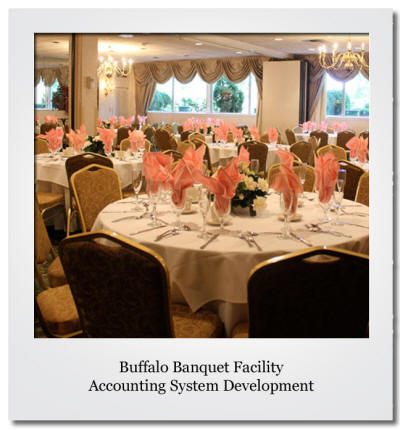
Buffalo Banquet Facility
 A Bookkeeper was hired in June 2012 to replace the previous Bookkeeper who left in April. By the time the new Bookkeeper was hired, there was no one at the facility who could train her in the accounting system. Deposits were made and checks were written, but no accounting was done or financial statements issued to management.
A Bookkeeper was hired in June 2012 to replace the previous Bookkeeper who left in April. By the time the new Bookkeeper was hired, there was no one at the facility who could train her in the accounting system. Deposits were made and checks were written, but no accounting was done or financial statements issued to management.
I was hired at the end of November 2012 to bring the accounting up to date and to train the Bookkeeper in the facility’s accounting system. My first task was to review the accounting entries made through the first three months of the year in the Quick Books General Ledger system. I ran the opening Trial Balance of the Balance Sheet accounts, and looked at the detail available. Cash, Accounts Receivable, and Customer Deposits Payable agreed to the detailed schedules and reconciliations. This was a good start. There was no detail for Prepaid Expenses, but I looked at the last journal entry to amortize this asset against the various expense accounts. In looking through the files of the vendors amortized, I could see when the amortization began, and set up a schedule to continue this process until the asset was fully amortized.
I reviewed the Daily Cash Sheet (used to record sales, customer deposits, and accounts receivable transactions) and determined how the entries generated from this document worked. Then I looked through the banquet invoices and started making the entries on the Daily Cash Sheets for each day of April. I reviewed the cash register tapes for the cash bars and entered those transactions on the appropriate Daily Cash Sheets. Each month, I continued this process through the rest of the year.
For the weekly payroll entries, I reviewed the entries made to Quick Books in the first three months of the year. Following the logic behind these entries, I pulled the Payroll Registers for April and wrote the appropriate journal entries to record payroll, employer payroll taxes, and various employee deductions. I set up a template in Excel that I could use each week to drop in the numbers off the Payroll Register and key into Quick Books.
To ensure that the journal entries I made that affected the two bank accounts (Depository and Payroll accounts) were correct, I reconciled these bank accounts each month. There were various charges to the depository account that needed to be recorded in Quick Books, such as bank fees, interest and payments on loans, and other direct debits. I set up standard journal entries to accomplish this task each month.
Since the facility was on the accrual method of accounting, I wrote standard monthly journal entries to accrue rent, accounting fees, income taxes, and other expenses that affected the month’s results, but would not be paid until a subsequent month. I also wrote monthly entries to depreciate the Fixed Assets on the books.
Each month, I recorded sales, payroll, and other expenses. Invoices paid through the Accounts Payable system had already been recorded in Quick Books. I closed each month and issued Profit and Loss Statements to management. It was the first time since the prior General Manager was terminated that management knew the profitability of its operations.
When the year was closed, I trained the Bookkeeper to record sales, accounts receivable and customer deposit activity through the Daily Cash Sheet. I also showed her how to complete the standard payroll entries from the data contained in the Payroll Register, and to record the monthly inventories. My job going forward was to reconcile the bank accounts and various balance sheet accounts to ensure they were correct, book accruals as needed, and to issue the financial statements to management.
(RETURN)
